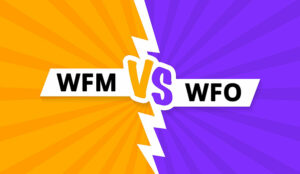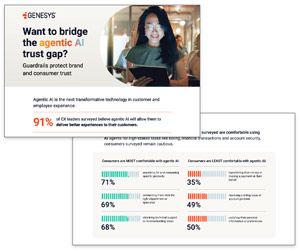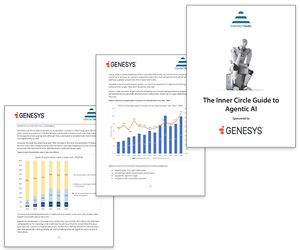Workforce management (WFM) and workforce optimisation (WFO) are both essential in managing contact centre operations. While they share common goals, their focus and scope differ.
To find out more, we asked Paul Turner, WEM Innovation Lead at Genesys , Nikki Quinn, Senior Solutions Consultant at Playvox, and Alex O’Donovan, WFO Consultant at Business Systems, to explain the key differences between WFM and WFO.
Video: What Is the Difference Between WFM and WFO?
Watch the video below to hear Paul, Nikki, and Alex discuss the difference between Workforce Management and Workforce Optimization:
With thanks to the following people for contributing to this video:
- Paul Turner, WEM Innovation Lead at Genesys
- Nikki Quinn, Senior Solutions Consultant at Playvox
- Alex O’Donovan, WFO Consultant at Business Systems
What Is Workforce Management (WFM)?
WFM is primarily about ensuring the right number of employees are available at the right time. It involves forecasting demand, scheduling shifts, and managing resources to meet service levels efficiently.
“Workforce management mainly focuses on efficiency, supply and demand, ensuring that you have the right resources in at the right time.
These solutions were generally around things such as service level, speed of answer, or perhaps even occupancy.” – Paul Turner
The key focus is on operational efficiency, such as reducing wait times and improving speed of service.
What Is Workforce Optimisation (WFO)?
“Workforce optimization was created when we started to link WFM solutions to other solutions, such as recording quality management and performance management.” – Paul
WFO builds on WFM by integrating additional tools, such as quality management, performance tracking, and employee training, as Alex outlines:
“WFO or workforce optimization, is a broad set of tools, technologies and processes, one of which is WFM. WFO can include but is not limited to things like ACDs, task workflow distributed systems, QM systems, training and coaching processes.
All of that, i.e. any process or system that makes your workforce better, i.e. optimizes them. And within that WFM is a system that allows you to create forecasts, and hence create, and manage, and automate schedules, and processes that fall out of that.”
It shifts the focus from efficiency alone to improving overall effectiveness, and by linking different workforce systems, contact centres can better support employees and enhance customer experiences.
The Evolution Towards Workforce Engagement
More recently, the approach has expanded to workforce engagement, which incorporates elements like gamification, employee recognition, and feedback systems, as Paul explored:
“Then what we did, we kind of lifted up that efficiency more to around effectiveness of our employees.
Today, though, we refer to this as workforce engagement, it builds upon WFO, workforce optimization, but then focuses on generating positive experiences for the employee.
You see additional things coming into that space, such as gamification and recognition. Perhaps bringing in onboarding and recruitment, and things such as voice of employee feedback, not just necessarily about the customer.”
This broader strategy aims to improve job satisfaction, performance, and retention by creating a more positive working environment.
The Orchestra Analogy
A useful way to think about the difference between WFM and WFO is to compare them to an orchestra, as Nikki explains:
“I think essentially WFM was all about business as usual, whereas workforce optimization was designed really to increase contact centre and agent efficiencies. I think the main difference between the two is the breadth of the tools.
I tend to liken them both to an orchestra.
So, if you think of an orchestra that’s about to play to an audience, all of the musicians know where to sit for a performance, and they know what instruments that they’re trained and skilled to play.
But when you bring in the conductor, they are essentially there to indicate the right tempo, keeping an ensemble of sometimes over 100 individuals, both focused and together.
They know when and how to optimize the musicians and instruments to create the best experience.
So, I think the conductor is the difference between WFM and WFO as I see it.”
WFM ensures that all musicians are in place and ready to play, while WFO brings in the conductor to fine-tune their performance, ensuring harmony and effectiveness.
Together, they create a well-coordinated and high-performing team.
If you are looking for more great insights from the experts, check out these next:
- The Algorithms Behind Chatbots
- A Quick Introduction to Interactive Voice Response (IVR)
- Understanding Customer Analytics
- When to Move from Spreadsheets to WFM
Author: Robyn Coppell
Reviewed by: Hannah Swankie
Published On: 11th Jul 2022 - Last modified: 25th Sep 2025
Read more about - Video, Alex O’Donovan, Business Systems, Editor's Picks, Genesys, Nikki Quinn, Paul Turner, Playvox, Videos, Workforce Management (WFM)



















